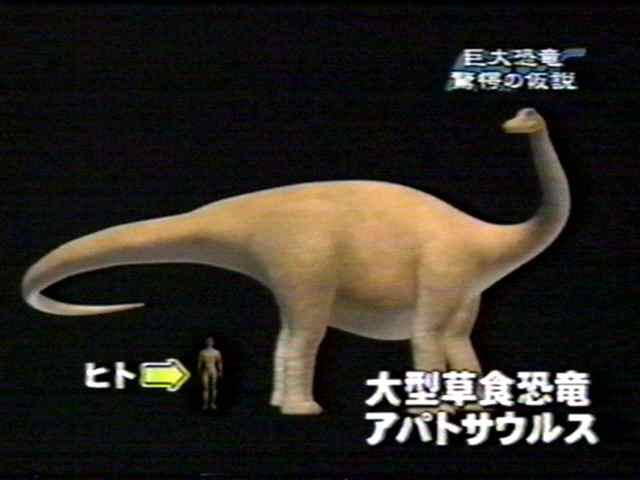|
|
||
 Credit: from a program produced by Office KEI and shown nationwide in Japan on February 22, 2004. |
||
|
pic of the day Links:
Society for
|
Nov 24, 2004 The giant dinosaurs are fascinating. How did they get so big? Why are there none alive today? Their size rivals that of modern whales, which cannot survive without the buoyancy of water. So early paleontologists postulated that the biggest dinosaurs must have spent most of their lives wading in the shallow seas of the Mesozoic Era. Then dinosaur footprints were discovered. Not just a few, but thousands of footprints. Somehow, even the largest of dinosaurs were walking around on land, not even dragging their enormous tails behind them. So wading in shallow seas was replaced by grazing in herds and the original reason for the wading -- that a dinosaur on land would have been a beached whale -- was forgotten. Catastrophist Ted Holden has resurrected the controversy by examining the relationship of size, weight, and strength in animals. (His analysis was the basis for a documentary televised in Japan in Feb, 2004. See photo above.) The strength of muscle tissue is fairly constant among all species. Strength is proportional to the cross section of the muscle: If one muscle is two times the diameter of another, the first will be four times (the square of two) as strong. But weight increases with the volume: A muscle that's twice as big will weigh eight times (the cube of two) as much. Holden computed the weight/strength ratio of a well-trained human weightlifter and scaled it up to the size of a dinosaur. The weightlifter soon became too big to lift his own weight. Strength, in its relationship with weight, imposes a limit on size. Holden's calculations indicate that the heaviest elephants of today approach that limit. The largest dinosaurs are many times the size of an elephant. And dinosaur skeletons aren't as well-designed for bearing weight as elephant skeletons. Dinosaurs are impossibly large for planet Earth, but their bones are proof that they must have existed. How could that be? The limit on size depends on weight, and weight depends on the force of gravity. Most conventional theories assume that gravity throughout the universe has always been and will always be a constant property of matter. But that's only an assumption, and it must be verified empirically. The Electric Universe offers a different point of view. Gravity is not a constant. It's a variable that depends on the plasma environment. So Earth in the Mesozoic Era may have had less gravity than it has today. Holden calculates that in order for the largest dinosaurs to function, gravity must have been at least 1/3 (and possibly as low as 1/4) what it is today. He also postulates that gravity increased suddenly at the close of the age of dinosaurs but not to the present value. Lower-than-present gravity continued into the following ages of giant mammals and possibly even to the days when early humans were building giant monuments like Stonehenge. |
|
|
Copyright 2004: thunderbolts.info |
||
